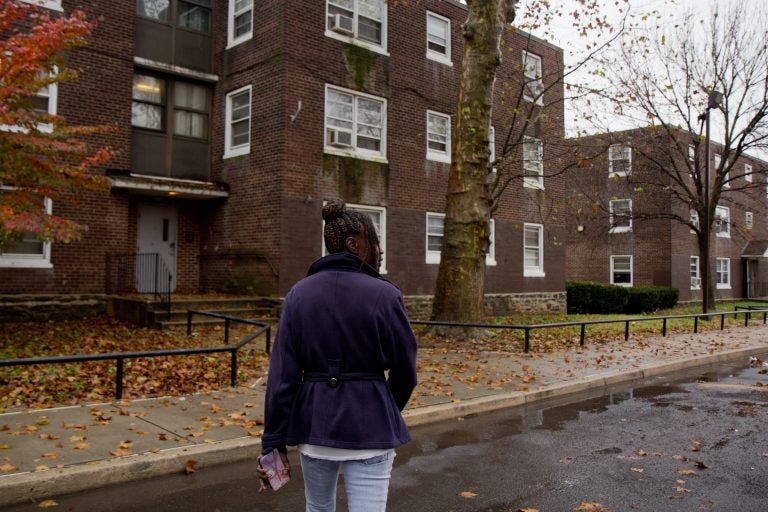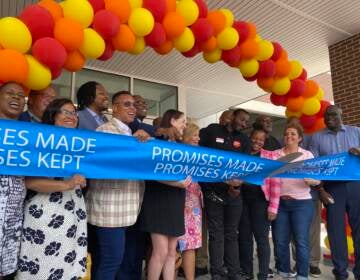Community development 101 comes to Bartram Village
How do neighbors start organizing for changes in their community?

Vanessa Harris has lived at Bartram Village for 4 years. (Kimberly Paynter/WHYY)
This article originally appeared on PlanPhilly.
—
How do neighbors start organizing for changes in their community?
For Sheila Anthony, president of Bartram Village Resident Council, the answer boils down to one simple word: education.
“Because what you don’t know can hurt you,” Anthony said.
That idea is the motivation behind a new Philadelphia Housing Authority initiative, the Neighborhood Leadership Series. A series of six two-hour seminars offering Bartram residents a crash course in city planning and community development, the program is designed to prepare residents to participate in the creation of a federally mandated and funded community-driven redevelopment plan for the Southwest Philly public housing development and the surrounding Kingsessing neighborhood.
“Public meetings are important,” said Kyle Flood, senior advisor to PHA president and CEO Kelvin Jeremiah. “But in some cases it’s important to really drill down on specific topics and really go into some level of detail so folks have some understanding of a given topic, whether that be affordable housing, or how planning and zoning work.”
The 22-acre, low-rise development of 41 brick buildings resembles an old army barracks. The rundown complex draws complaints of aging infrastructure, insufficient lighting, and general safety concerns due to crime.
“The buildings need to be done over altogether,” said Vanessa Harris, who has lived there for four years. “Everything in it is old. The buildings are dilapidated. They’re dirty, filthy inside, and it’s horrible to have to live that way.”
Flood said the complex, built during World War II to house workers building weapons and warships, “was never intended to be a permanent residential community.”
Earlier this year, PHA won a $1.3 million U.S. Department of Housing and Urban Development planning grant to kickstart the redevelopment of the outdated complex. The feds require the agency to come up with the community-driven plan by early 2020. If the plan meets the necessary requirements, the housing authority will be eligible for an implementation grant to start construction.
Since receiving the grant, the agency has hosted public meetings and issued surveys to gather resident feedback concerning the future of the struggling neighborhood. Flood and others hope the new leadership course will encourage residents to play a larger role in moving the redevelopment forward in a way that meets their needs.
“That’s really how we came to the decision to apply for this type of grant for Bartram Village,” said Flood. “If we’re looking to invest in excess of $100 million, maybe it’s worth taking a step back and really taking a look at the larger context.”
The first class was held on Nov. 15 and the course will run through Feb. 7, 2019, with a break between Dec. 13 and Jan. 17.
The series will culminate with a graduation ceremony.
“I think [the course] is a very good incentive for us to come and learn different things,” said Anthony.
The topics that will be covered include neighborhood planning, collaborating as a community, city planning, affordable housing, community mental health and healing, and organizing.
Another subject sure to surface is the broken trust between residents and the housing authority.
“A lot of people are hopeless to a lot of things they’re telling us,” said Harris. “Because they haven’t kept their word in the past.”
The course is a step towards repairing that relationship. PHA officials acknowledge that the agency fell short of meeting residents’ needs in past redevelopment efforts. Under the Hope VI Program, the HUD public housing improvement program that preceded Choice Neighborhoods, public housing units were demolished and replaced with an insufficient amount of new units, displacing residents.
PHA lost nearly 7,000 affordable units.
Under current Choice Neighborhood regulations, local housing agencies must replace demolished units one-for-one and offer residents in good standing a right to return.
“PHA and other public agencies in the past promised certain things and not always delivered,” said Flood. “And I think that’s a barrier that we need to overcome.”
Anthony said that while the ongoing conversations between residents and housing officials are positive, the real test will be when “the trucks” come.
“They’ve been hearing for years that they were going to do something with Bartram and it never came to pass,” said Anthony. “But now it’s actually in the process. And once we start making designs and things like that, it’s really going to change a lot of people’s minds.”
WHYY is your source for fact-based, in-depth journalism and information. As a nonprofit organization, we rely on financial support from readers like you. Please give today.







